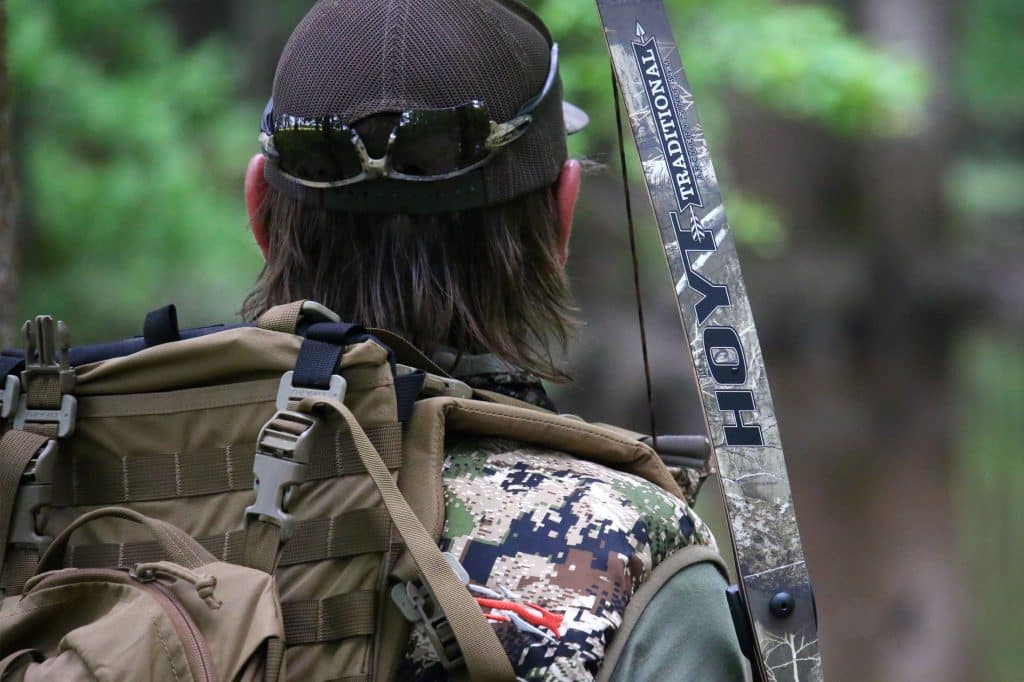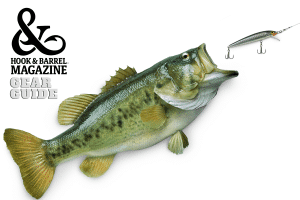
Transitioning to traditional archery requires a multi-layered approach. From choosing gear to knowing your methods, here’s the straight arrow on how to get it done.
The bow string pulls back with ease, and everything comes into alignment. You reach that millisecond where everything is in sync. Much in part to second nature, your body recognizes this state of eminence, and the shot breaks. The arrow hits its mark squarely, transcending all expectations — the perfect shot.
Those considering traditional archery should understand the challenges. These are many, but the rewards are worth the time developing necessary skills. Few traditional archers understand this better than Johnathan Karch, president of 3Rivers Archery.
“There’s so much added to the shot with traditional archery,” Karch said. “When you bring it down to its bare basics, there’s a lot of reward. When you’re able to connect, make it happen, and shoot that perfect shot, it’s satisfaction.
Most modern hunters are familiar with compound archery equipment. There are major differences between this and traditional archery, though. When transitioning to trad bows, there are new skills to learn and challenges to overcome.
“The biggest thing for a lot of folks is draw weight difference,” Karch said. “You know, a 70-pound compound bow is common. You aren’t doing that with traditional. Myself, I recommend starting much lower than wherever you are with a compound.”
There are similarities with the muscles used for shooting both traditional and compound bows. However, there are huge differences between pulling these different types of bows, and you want the weight to be comfortable.
Another major but obvious difference is the accessories. On traditional equipment, accessories are limited. Some might use a flipper rest, but most shoot off the shelf. There might be silencers on the string and limbs, but most purists won’t even take it that far. Of course, there are no peeps, sights, stabilizers, or other modern equipment pieces used on these bows.
“It’s just completely different,” Karch said. “There’s no breakover in your draw length. It’s 100% reliance on you as the archer to make everything work. Having that responsibility can be unnerving for folks.”
So, if you’re ready to go trad, be prepared to throw out everything you thought you knew about archery. Going traditional is a completely different skill. Here’s the basics of what you should know.
Traditional Archery 101
Get the Right Gear

Trad archers tend to be serious gear nerds. The best way to learn about trad gear is to head to your local archery shop and see if they know anyone that can help. They also may have a few bows you can draw back for scale. Or, check out Karch’s 3Rivers Archery online store. 3Rivers specializes in everything trad. 3Rivers also recommends shooting schools, builds educational resources, and more.
A good bow is your starting point. And the most crucial aspect of this is selecting one with the right draw weight, which is determined by the limbs. It might be good to start with an affordable manufactured bow, but there are also a lot of amazing trad bow makers out there in the world that can customize a bow for you once you know what you want.
You’ll also need to choose the right arrows. There are pros and cons to shooting different arrow weights, and these affect the amount of kinetic energy upon impact.
Once the arrow is chosen, select a broadhead to use. Traditional archers should select reliable field points and fixed-blade, cut-on-contact broadheads that match in weight.
Other items to get include a quiver, armguard, glove (or finger tab), bow stringer, and anything else needed for your setup.
Choose a Shooting Method
Once you have the right gear, it’s time to select a shooting method.
Some archers opt for the split-finger approach, which most competitive traditional archers use. This involves placing your index finger slightly above the nocking point, and your middle and ring fingers slightly below it. The other method is three under, which involves placing all three fingers below the nocking point. This seems to be a more popular choice for hunters.
Next, choose between the right finger hook. Some prefer a shallower hook, while others like a deeper hook. Of course, this can impact how well you can comfortably draw a bow, and how well you release the shot. Remember, you want as little tension in your drawing arm as possible, especially in the forearm, wrist, and hand.
Develop Excellent Form
For those who are new to traditional archery, there are some things that can help beat the learning curve. Form is the foundation of good shooting, and technique is much more important than brute strength. Use geometry to your favor. At full draw, your body, bow, arrow, everything must be in line with the target. The right form facilitates this.
Start by getting your feet right. Keep them about shoulder width apart. Use a slightly open stance at full draw.
“It’s all about form,” Karch said. “Focus, focus, focus on the form. Having that as perfected as you can get will pay dividends down the road. Having that form built into your base is big.”
Next, determine how much cant (or tilt) you’ll use when shooting. You’ll need at least some cant to keep the arrow on the shelf, ensure a good sight window, and to improve overall accuracy.
Bow hand position is the next factor. Create a V between your thumb and index finger. This helps apply the correct pressure and tension for good shooting. It also makes it easier to align everything. It even minimizes the amount of contact between your bow hand and the bow itself, which reduces the amount of torque and negative influence you apply to the bow, which can throw off your shot.
String hand position is another important consideration. Have an open grip. Don’t choke down on it. Lay your point across the front of the grip to keep it from jumping out of your hand after the shot. Don’t roll your hand too far in or out.
Also, have consistent anchor points. Anchor the same way each time. For example, one consideration is ensuring the nocking point is just below your eye each time you draw. It’s important to have at least two to three markers you can replicate with each shot.
Finish by implementing proper back tension. This motion aligns everything during the shot process. The bow hand remains stationary. But the shooting hand does the work. Pinch your string-hand-side shoulder blade to release the shot.
Learn How to Aim
Those who try traditional archery equipment will quickly realize how difficult it is. Selecting an aiming method and perfecting it will make it simpler. The first option is instinctive shooting. This is where the aiming process is mostly completed on a subconscious level. It’s much like throwing a ball. So, in essence, you don’t actually aim.
Split vision is similar. You focus on the target, but you’re more aware of everything than with instinctive shooting. So, you focus on your arrow tip and the target interchangeably.
Some people can’t shoot instinctively or with split vision, though. These must learn to aim in its truest form. They must get on target, look at it, and view the arrow tip with peripheral vision. This helps dial in the windage (left and right) accuracy. That said, a degree of instinctive shooting remains for elevation (up and down) point of impact. Of course, the distance will impact how far below or above the bullseye the tip of the arrow should be upon releasing the string.
Then, it’s crucial to determine your bow’s point-on distance. This is the yardage at which, when at full draw, you can place the tip of your arrow on the bullseye and hit it.
Master Follow Through
The follow through is the final stage of the shot process, but it’s no less important than each step that precedes it. Because of this, it’s important to not pull your head up, drop the bow, or choke the bow grip, following the release of the arrow. Don’t pull out of your stance until the arrow hits the target.
Once you’ve ironed out the entire shot process, it’s crucial to replicate it. Be able to repeat your entire shot process and commit each part to muscle memory. Not doing so will result in inconsistencies.
Elevate Your Traditional Archery Gear Knowledge
Some traditional archers already know the ropes. They’ve learned the basics and graduated to intermediate or advanced shooting. Still, even these archers can grow and become better at their craft. It’s time for them to take it to the next level.
Those who are ready to move on from more basic and elementary concepts should start by elevating their gear. One example is tuning the bow string. Start by making slight twists (or untwists) in your bow string. This will gradually change the brace height of your bow, and each one performs best at a certain brace height.
Then, move to the projectile. “Really drill down on that arrow,” Karch said. “There are so many ways to tune it and make sure it’s right. Bare shaft tuning is a big one. Paper tuning. To get to that next level, or getting to where it needs to be, have gear tuned perfectly.
“Just buy better gear,” Karch continued. “Precision-tuned arrows are worth it. Buy test kits. Try different things. When everything is right, that’s when you’ll start elevating your game, competitively or when hunting.”
Furthermore, consider putting silencers on your bowstring. Also, number your arrows to determine which ones perform best.
Avoid Common Mistakes
Good practices aside, there are common mistakes that can hold back traditional archers, beginners and experienced shooters alike. One is by biting off too much.
“The challenge is appealing to someone who is starting out,” Karch said. “They like it because it is very rewarding. But start close. Don’t start at 20 yards. Start at 5 yards and back up from there.”
Of course, there are many other mistakes, but there are more obvious blunders to avoid, such as: using unreliable shooting techniques; gripping the bow incorrectly; using too deep of a finger hook; trying to snap shoot; raising your head or dropping the bow until the follow through is complete; practicing too much at once; and more.
“Work out a shooting routine,” Karch said. “That might not be every day, but let’s pick what’s doable, and even a little shooting is better than no shooting. If you can only get out twice per week, that’s better than, starting in September for an October hunt.”
Traditional Archery: A Trad Fad or Fixed Tradition?
Traditional archery was here before more advanced forms of the trade were developed. Today, we have compounds, crossbows, and hybrid-style archery equipment, such as airbows, but all were based on the primitive baseline technology of traditional equipment. So, traditional archery isn’t anything close to a fad. It’s been around for thousands of years. It’s still popular today. But in terms of modern usage, there is certainly a clear trajectory on how much it’s being used. It’s trending upward.
In the past, you’d almost always see that transition from compound back to traditional equipment. They’d begin with modern equipment and work back toward more primitive archery gear. Today, some aspiring archers are bypassing compounds and jumping straight into traditional gear.
“We’re seeing a lot of growth,” Karch said. “Under normal living, there was a cycle for it. You would see it hit a growth phase every 10 years or so. People would come off the compound looking for a challenge. Currently, since media and pandemics have come into play, we’ve seen a lot more growth.”
So, no, it isn’t a fad. And you’re missing out if you don’t jump on the wagon. Go traditional. You’ll be glad you did. “There’s a bit of romance to it,” Karch said. “There’s the challenge of it. And I really do believe people like the experience that traditional archery has to offer.”
Tips for Tighter Archery Groups

























